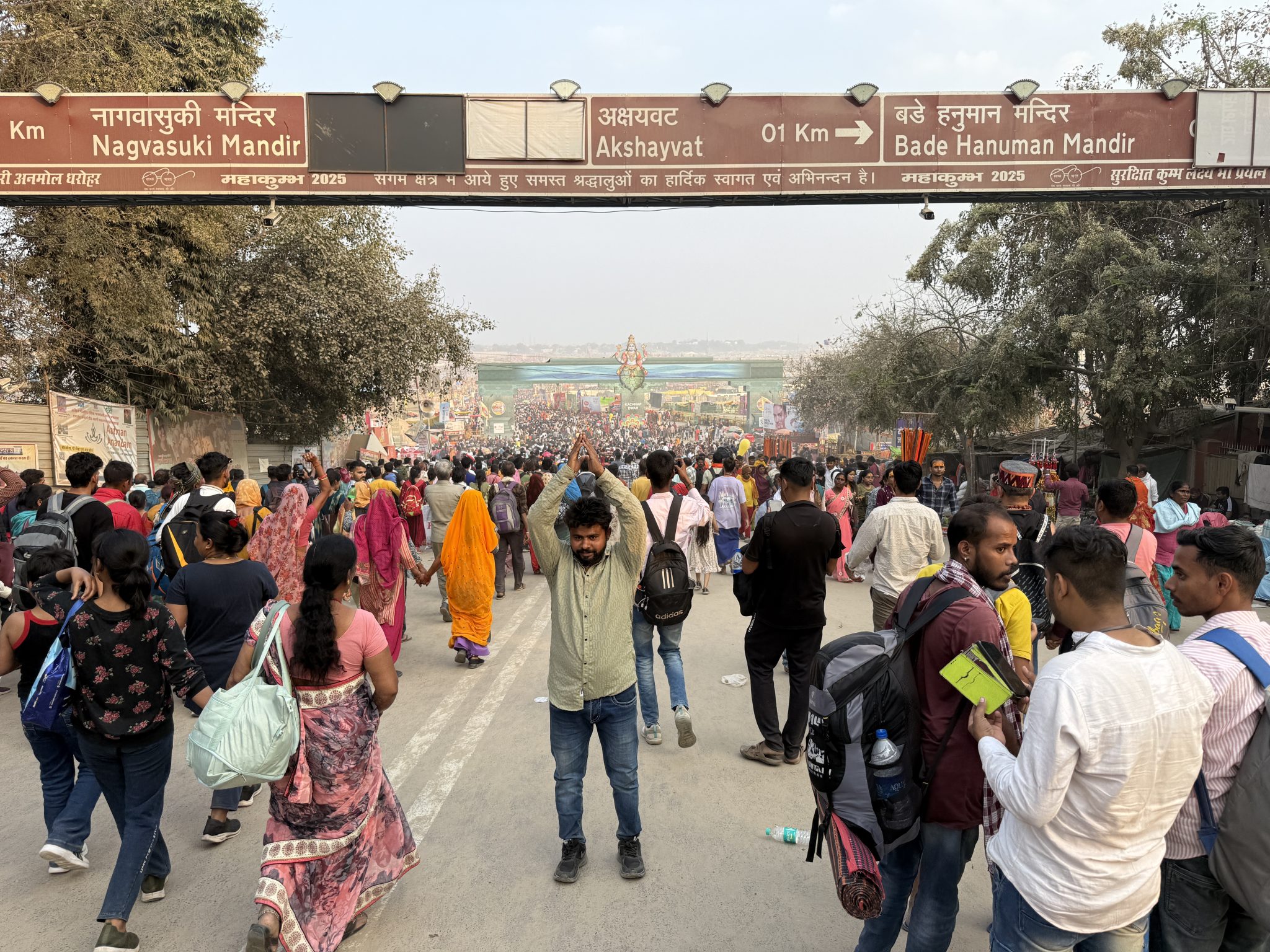


























































































































When I arrived in Prayagraj in February 2025, the Maha Kumbh Mela was in its final days. For weeks, this city at the confluence of the Ganges, Yamuna, and the invisible Saraswati had been the stage for what is often described as the largest gathering of humanity on earth. The crowds had begun to thin by the time I arrived, yet the scale was still breathtaking: a vast tent city stretching across the sandy floodplains, pilgrims streaming along makeshift avenues, smoke rising from sacred fires, and the constant hum of devotional chants rolling across the river.
The Maha Kumbh Mela is more than a festival; it is a living mythology, a ritual enacted at cosmic scale. Its origins lie in the legend of the Samudra Manthan — the churning of the ocean of milk. As gods and demons battled for the pot (kumbh) of amrita, the nectar of immortality, drops spilled to earth at four places: Prayagraj, Haridwar, Ujjain, and Nashik. These sites became sanctified, their waters believed to carry divine power at specific planetary alignments. At Prayagraj, the alignment of Jupiter, the Sun, and the Moon determines the timing of the Kumbh, and in 2025, the stars foretold the gathering of millions.
Statistics only hint at the immensity of the Kumbh. The Uttar Pradesh government estimated that over 150 million pilgrims would visit during the 48-day span from January 13 to February 26. On peak bathing days — Shahi Snans — more than 30 million people entered the water within hours. The festival grounds sprawled across more than 4,000 hectares, with over 100,000 temporary tents erected for accommodation. The state deployed over 20,000 police and security personnel, set up 1,500 CCTV cameras, and installed thousands of toilets and water taps to manage sanitation. The logistics were staggering: a temporary city larger than many nations, complete with electricity grids, medical camps, fire brigades, and even post offices.
And yet, despite the infrastructure and the staggering numbers, the Kumbh remains at its heart an act of faith. Pilgrims arrive not for spectacle but for salvation — the chance to take a purifying dip at the Sangam, believed to cleanse lifetimes of sin and bring the soul closer to liberation (moksha).
As I made my way toward the confluence, I joined a steady current of humanity moving across pontoon bridges and sandy tracks. Entire families walked hand in hand, women carrying bundles on their heads, children clinging to parents. Bands of saffron-clad sadhus passed by, some barefoot, some chanting, some silent. The air was alive with devotion: the shout of “Har Har Gange!”, the clang of temple bells, the metallic cry of conch shells.
Hiring a wooden boat, I was rowed toward the meeting point of the rivers. The Yamuna, darker and calmer, flowed into the lighter, silty Ganges, and somewhere unseen beneath them was the Saraswati, the lost river of Vedic lore. Here, the water shimmered with a strange energy, as if embodying the myth that had drawn millions.
Stepping into the river, I felt the cold bite into my skin. I clasped my hands, whispered a prayer, and dipped beneath the surface. Once, twice, three times. Each time, the current tugged at me, carrying away the dust of the road, and something deeper — a symbolic cleansing, if not a literal one. Around me, pilgrims shouted, laughed, wept, or simply closed their eyes in silence. We were each alone in that moment, yet part of a collective ritual stretching back millennia.
The Kumbh Mela has been recorded in texts for over a thousand years. Chinese traveler Hiuen Tsang described a similar gathering in the 7th century. The 19th century saw British colonial officials marvel at the sheer numbers of pilgrims. Today, it is recognized by UNESCO as an Intangible Cultural Heritage of Humanity. Every Kumbh is vast, but the Maha Kumbh, which occurs only once every 12 years at Prayagraj, is of an altogether different magnitude. Some historians note that a “Purna Kumbh” (full Kumbh) happens every 12 years, while a “Maha Kumbh” (great Kumbh) occurs only after 144 years, though popular usage blurs the distinction.
For ascetics, especially the Naga Sadhus, the Kumbh is a defining moment. On auspicious bathing days, they process toward the river in dramatic Shahi Snans — royal baths — their ash-smeared bodies gleaming, tridents held aloft, their chants shaking the air. To witness this is to glimpse a continuity of religious practice that has endured across centuries, binding the past to the present.
Behind the devotion lies immense complexity. Crowd management is a perpetual challenge; past Kumbhs have seen stampedes and tragic loss of life. In 2025, despite extensive preparations, there were reports of overcrowding and accidents. Environmental concerns also loom large. The Ganges, already strained by pollution and dams, struggles under the weight of millions of bathers and the detritus of mass gatherings. Authorities set up sewage treatment plants and banned plastic at the festival grounds, but the tension between faith and sustainability remains unresolved.
When I left Prayagraj, just a couple of days before the final ritual baths, the city was already beginning its slow return to normalcy. Pilgrims were boarding trains and buses, tents were being dismantled, and the temporary avenues across the floodplain would soon vanish under the river’s rising waters. Yet the memory of the Mela — and of my own small part in it — lingered.
For me, the Kumbh was not just about numbers, or even about ritual purity. It was about standing in a river beside millions of others, linked by faith, by myth, by history. It was about the humbling realization that I was part of something unimaginably vast, and yet profoundly human.
The Maha Kumbh Mela 2025 will be remembered for its scale, its challenges, its spectacle. But for me, it will be remembered in a single image: the moment I rose from the cold waters of the Sangam, droplets sparkling in the sun, the chants echoing across the river, and the feeling — however fleeting — of being washed clean, connected to eternity.